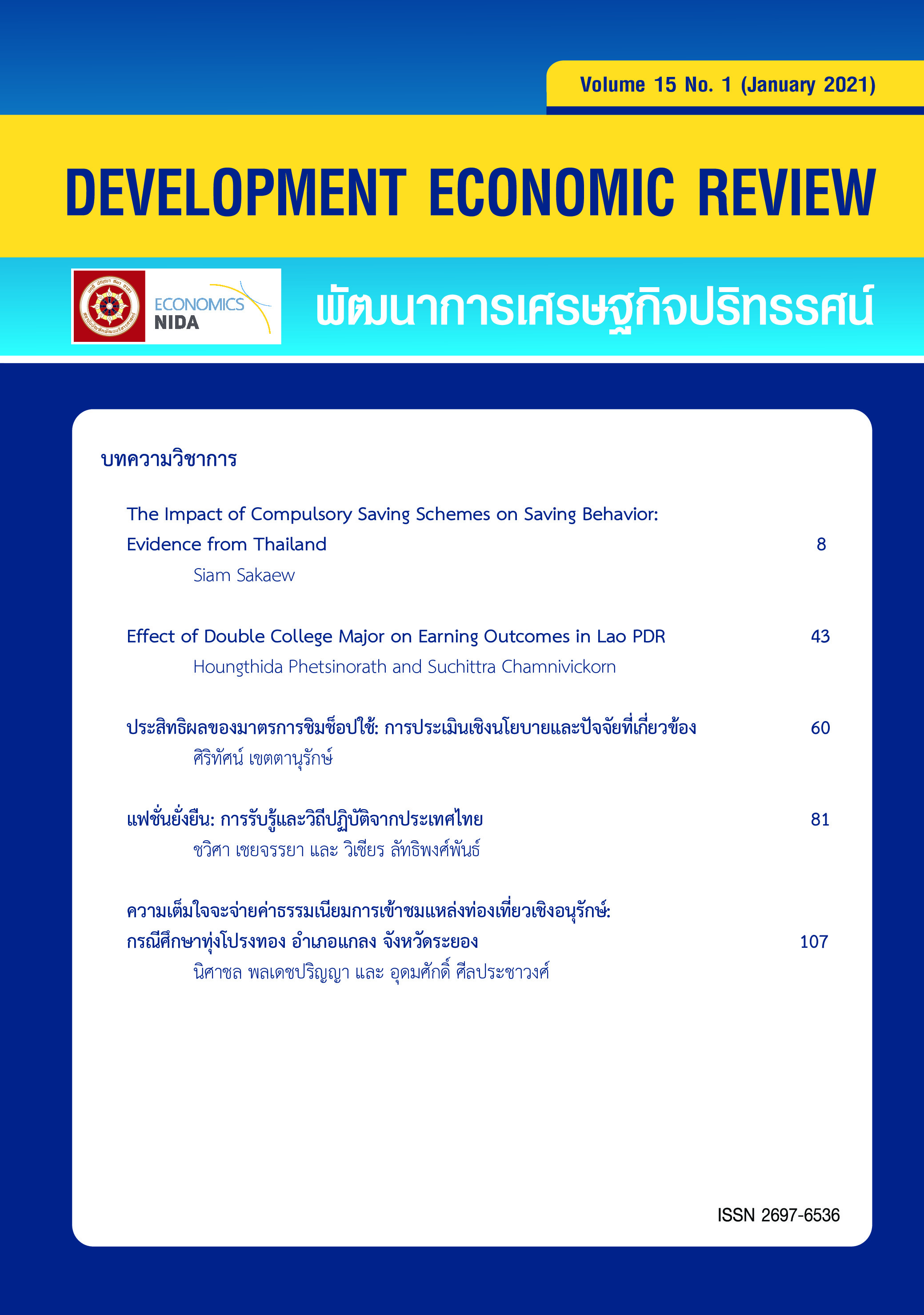The Impact of Compulsory Saving Schemes on Saving Behavior: Evidence from Thailand
Keywords:
Compulsory Saving Schemes, Saving Behaviors, Blinder-Oaxaca Decomposition Method, Informal Workers, ThailandAbstract
Thailand has many compulsory saving schemes for longevity and income uncertainty at old age. A crucial question is whether how saving schemes affect saving behavior. The Blinder-Oaxaca decomposition method shows that compulsory saving systems induce formal workers to save more than informal workers. Because compulsory saving is one of the saving channels that offers a high return to savings and provides the other social welfares that reduce the cost of living. However, low-income informal workers have a higher saving incentive to compensate for the lack of compulsory savings. Moreover, the difference in the compulsory saving schemes between government employees and private employees induce private employees to save more than government employees.
References
Attanasio, O.P. & Brugiavini, A. (2003). Social Security and Households’ Saving. Quarterly Journal of Economics, 118 (3), 1075-1119.
Attanasio, O.P. & Rohwedder, S. (2003). Pension Wealth and Household Saving: Evidence from Pensions Reforms in the United Kingdom. American Economic Review, 93(5), 1499-1521.
Bebczuk, R., Gasparini, R., Amendolaggine, J., & Garbero, N. (2015). Understanding the Determinants of Household Saving: Micro Evidence for Latin America. Inter-American Development Bank Working Paper Series 843, Washington, D.C.: Inter-American Development Bank.
Beckmann, E., Hake, M. & Urvová, J. (2013). Determinants of Households’ Savings in Central, Eastern, and Southeastern Europe. Focus on European Economic Integration, 3, 8-29.
Blinder, A.S. (1973). Wage Discrimination: Reduced form and Structural Estimates. Journal of Human Resources. 8(4), 436-455.
Blinder, A.S., Gordon, R.H. & Wise, D.E. (1981). Social Security, Bequests, and the Life Cycle Theory of Saving. NBER Working Paper 619. Cambridge, MA.: National Bureau of Economic Research.
Bozio, A., Emmerson, C., O’Dea, C. & Tetlow, G. (2013). Saving and Wealth of the Lifetime Rich: Evidence from the UK and US. IFS Working Paper W13/30. Institute for Fiscal Studies.
Browning, M. & Lusardi, A. (1996). Household Saving: Micro Theory and Micro Facts. Journal of Economic Literature, 34(4), 1797-1855.
Chandavarkar, A. (1993). Saving Behavior in the Asian-Pacific Region. Asian-Pacific Economic Literature, 7(1), 9-27.
Chyi, Y.L. & Liu, Y.L. (2007) Income Uncertainty and Wealth Accumulation: How Precautionary are Taiwanese Households? Asian Economic Journal, 21(3), 301-319.
Deaton, A. (1991). Saving and Liquidity Constraints. Econometrica, 59(5), 1221-1248.
Diamond, P.A. & Hausman, J.A. (1984). Individual Retirement and Savings Behavior. Journal of Public Economics, 23 (1-2), 81-114.
Dynan, K.E., Skinner, J. & Zeldes, S.P. (2004). Do the Rich Save More? Journal of Political Economy. 112(21), 397-344.
Engelhardt, G.V. & Kumar, A. (2011). Pensions and Household Wealth Accumulation. Journal of Human Resource, 46(1), 203-236.
Feldstein, M. (1974). Social Security, Induced Retirement, and Aggregate Capital Accumulation. Journal of Political Economy, 82(5), 905-926.
Feldstein, M. & Pellechio, A. (1979). Social Security and Household Wealth Accumulation: New Microeconometric Evidence. Review of Economics and Statistics, 61(3), 361-368.
Feng, J., He, L. & Sato, H. (2011). Public Pension and Household Saving: Evidence from Urban China. Journal of Comparative Economics, 39(4), 470-485.
Gale, W.G. (1998). The Effects of Pensions on Household Wealth: A Reevaluation of Theory and Evidence. The Journal of Political Economy, 106 (4), 706-723.
Gandelman, N. (2015). Do the Rich Save More in Latin America? IDB Working Paper Series No. IDB-WP-588, Washington D.C.: Inter-American Development Bank.
King, M.A. & Dicks-Mireaux, L.D.L. (1982). Asset Holdings and the Life-Cycle. Economic Journal, 92(366), 247-67.
Kraay, A. (2000). Households Saving in China. The World Bank Economic Review, 14(3), 545-570.
Lusardi, A. (1997). Precautionary Saving and Subjective Earning Variance. Economic Letters, 57(3), 319-326.
Lusardi, A. (1998). On the Importance of the Precautionary Saving Motive. American Economic Review, 88(2), 449-453.
Lusardi, A. (2008). Household Saving Behavior: The Role of Financial Literacy, Information, and Financial Education Programs. NBER Working Paper 13824. Cambridge, MA: National Bureau of Economic Research.
Lusardi, A. (2008). Financial Literacy: An Essential Tool for Informed Consumer Choice.? NBER Working Paper No. 14084. Cambridge, MA.: The National Bureau of Economic Research.
Lusardi, A. & Mitchel, O.S. (2007). Financial Literacy and Retirement Preparedness: Evidence and Implications for Financial Education Programs. Michigan Retirement Research Center Research Paper No. WP 2006-144. Retrieved from SSRN: https://ssrn.com/abstract=957796 or http://dx.doi.org/10.2139/ssrn.957796
Mishra, A.K., Uematsu, H. & Powell, R.R. (2012). Precautionary Wealth and Income Uncertainty: A Household-Level Analysis. Journal of Applied Economics, 12(2), 353-369.
Mosk, C. (2010). Japanese Industrialization and Economic Growth, University of Victoria, retrieved from https://eh.net/encyclopedia/japanese-industrialization-and-economic-growth/National Statistical Office. (2018). The Informal Employment Survey. Bangkok. The Ministry of Information and Communication Technology.
Pan, Y. (2016). Understanding the Rural and Urban Household Saving Rise in China. Regional Science and Urban Economics, 56(C), 46-59.
Pootrakool, K., Ariyapruchya, K. & Sodsrichai, T. (2005). Long-term Saving in Thailand: Are We Saving Enough and What Are the Risks? Discussion Paper 2005-03. Bangkok: Bank of Thailand.
Sirisankanan, A. (2013). Consumption Smoothing and Precautionary Savings in Thai Agricultural Households. Thammasat Economic Journal, 31(2), 37-63.
Zeldes, S.P. (1989). Consumption and Liquidity Constraints: An Empirical Investigation. Journal of Political Economy, 97(2), 305-346.

Downloads
Published
Issue
Section
License
Copyright to published manuscripts becomes the property of the Graduate School of Development Economics, National Institute of Development Administration. Reproduction of all or part of a Development Economic Review (DER) article by anyone, excluding author(s), is prohibited, unless receiving our permission.
Disclaimer: Opinions expressed in articles published in this journal are those of the author (s) and do nto necessarily represent opinions of the Graduate School of Development Economics, National Institute of Development Administration. Trade and proprietary names are only for identification and not constitute our endorsement.

